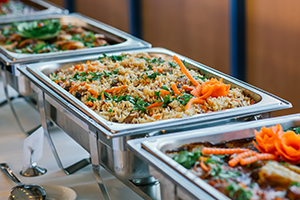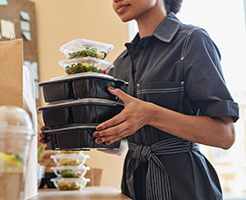
Every workplace leader worth their salt knows that food is what opens the door to better employee experiences. In fact, it could be the very thing that gets employees to work on site and stay with the company. The latest What’s Happening in the Workplace Now?” survey from Fooda even found that 80% of employees feel more enthusiastic about work when the company provides free food.
But in spite of this knowledge, setting up successful corporate dining solutions is a challenge for many companies. Between the struggle to navigate your options and understand how to implement them, you may still be stuck figuring out the basics.
In this post, we dive deeper into the different corporate dining services you can choose from and the questions you should ask to find the best option. Let’s take a look.

Corporate dining solutions refer to on-site meal programs where employers provide food to their employees. By providing convenient access to food, companies can help employees save time and improve productivity. It’s also a great way to enhance satisfaction while fostering workplace culture. As a result, this could even make employees want to stay with the company, boosting employee retention.
Typically designed for medium-to-large workplaces, you can find solutions that leverage different models. For example, companies may have self-managed cafeterias or outsource cafeteria services to a provider. Some companies may also order catering or have food delivered from local restaurants.
Alternatively, you can even find restaurant-partnered programs like Orange by Fooda, where you bring local restaurants into the office. Under this program, food is cooked on-site instead of being delivered from outside.
So corporate dining services extend far beyond traditional cafeterias and involve solutions that are more flexible and sustainable for the modern workplace.
To get an even better understanding of the different corporate dining solutions that you can choose from, let’s give you a detailed breakdown of the most common options.
Most businesses are familiar with traditional cafeterias where the company provides a complete on-site dining experience. Some companies manage the cafeteria in-house, while others outsource the services to a vendor.
This type of corporate cafeteria solution tends to offer predictability, often relying on a set menu for employees to choose from. But this leaves you more prone to menu fatigue, as employees get tired of having to choose from the same menu over and over again.
Traditional cafeterias also give you better control over the kitchen, which ensures better compliance with hygiene and quality standards. At the same time, the day-to-day management can be time-consuming and labor-intensive. Not to mention the high fixed costs associated with maintaining a dedicated kitchen and workforce.
There’s also limited flexibility since cafeterias typically have to prepare a large amount of food every time. Since they can’t accurately anticipate demand, it may be challenging to adapt to fluctuating attendance. So there’s a high chance that you’ll end up with food waste, which ultimately contributes to higher costs.

Some organizations also rely on office catering, which involves bringing in caterers to serve pre-prepared meals on demand, usually buffet-style or as individual meals. This option is highly flexible since meals are ordered ahead of time, which means you can account for attendance along with each employee’s dietary needs and preferences.
It also tends to offer variety on demand, allowing you to choose from an expansive catering menu. However, corporate catering programs can get expensive depending on the menu, which also means they’re not a sustainable choice for meeting your company’s daily needs. Instead, you could use them for special events like holiday celebrations, meetings, or occasional team dinners.

Companies may also opt to have food delivered directly from nearby restaurants. This is one of the most flexible solutions since you don’t need on-site infrastructure, and you can place orders based on employee demand. So it’s a popular choice for workplaces with a hybrid setting.
Each employee can submit an order through an admin, allowing them to have full control over what they eat. This flexibility adds to the appeal of office food delivery services, especially for smaller teams that don’t have the infrastructure for on-site dining.
On the flip side, you may have to deal with higher per-meal costs compared to other corporate dining solutions. There’s also the issue with inconsistent quality and the risk of logistics issues. For instance, late deliveries could clash with your employees’ schedules. Not to mention the mental load of deciding between restaurants on a daily basis.
For the most flexible solution that offers the right balance of variety and consistency, companies may also take a hybrid approach to corporate dining. With services like Orange by Fooda, you can seamlessly combine solutions like resident restaurants and rotating local restaurants along with micro markets for greater variety.
This lets you scale your corporate dining services effortlessly based on employee demand and attendance. Since food is prepared on demand, you can effectively minimize food waste and reduce costs. Plus, employees get to order what they want when they want it. Since there’s a variety of options to choose from, especially with rotating menus, it’s the best way to beat menu fatigue.
Although a hybrid approach requires some light on-site coordination, you can simplify it with tech-enabled ordering and professional management. You also need a strong restaurant network to ensure better variety and maintain food quality.
Knowing your options is just the first step to figuring out the best corporate dining solution for your business. You also need to assess each option to see how it aligns with your unique needs. This means considering factors like business size, attendance, budget, infrastructure, and more.
Asking the following key questions will help you simplify the assessment process.

· How flexible is the program?
· Does it let you combine multiple dining services?
· Is it possible to customize menus according to employee demand?
· Can it scale as policies and attendance shift?

· Does the cost of the program align with your budget?
· For employee-paid programs, is the cost reasonable for employees?
· Is there a clear, itemized list of all the associated costs?
· Is there a plan in place for cost allocation to maintain financial transparency?
· How does the program handle subsidies?
· Does it require on-site infrastructure?
· If yes, what infrastructure does it involve?

· Will employees actually value the food?
· Does it offer enough variety to meet employee expectations?
· Does the program offer healthy and sustainable food choices to support employee wellness?

· Do they offer technology for online ordering?
· Does the tech support digital payments?
· Does it have a robust reporting and data dashboard?
· Can it work seamlessly with your existing business systems?

· What role do local restaurants play?
· Do they offer on-site management assistance, such as a Catering Manager or Coordinator?
· What level of hospitality and service standards can you expect?

Orange by Fooda offers a modern solution to your greatest office dining dilemmas. With flexible and scalable corporate dining services, you can build a program that fits the specific needs of your business while maintaining employee satisfaction.
That’s why Fortune 500 companies and growing startups alike choose the Orange by Fooda solution, which has served 100M+ meals powered by a network of 2,500+ restaurants.

With Orange, you can tap into an expansive network of local restaurants to deliver authentic food experiences within the workplace instead of relying on faceless commissaries.
You can bring in a rotating lineup of top local restaurants to keep your cafeteria menus fresh and exciting. This helps you serve food that your employees actually love while maintaining variety, so you can effectively solve the menu fatigue dilemma.
Orange also ensures greater flexibility, allowing you to bring in a blend of resident restaurants, rotating guests, and micro-markets. So employees always have a choice when it comes to finding a lunch option that fits their budget and schedule. They can effortlessly choose between grab-and-go lunches on busy days and sit-down meals on days they have more time.
Additionally, companies can seamlessly scale their corporate dining services according to employee demand and attendance. Since food is prepared on demand, you can minimize food waste while ensuring that there’s always enough to serve everyone. This means you can scale up or down based on your specific needs, making this an excellent choice for hybrid workplace setups.
Honest pricing is another Orange advantage that enterprise clients can enjoy. There are no hidden fees or inflated pass-through costs that could add to your expenses. This cost-controlled solution helps you align your workplace food program with your budget.

Worried about all the planning and coordination that comes with maintaining a successful workplace dining program? Orange simplifies it with a dedicated Catering Manager to assist you onsite for all your event planning needs. You can rely on professionals to take care of menu planning and coordinating between restaurant partners while you focus on your work.
Moreover, you can rely on trained on-site teams to maintain elevated hospitality standards across all locations. Our associates are trained to bring care, precision, and warmth to every service moment. So you can create dining experiences that your employees love, making them want to keep coming back.

Orange offers powerful technology and tools to efficiently manage various aspects of your office dining operations. This includes apps for online ordering so employees can order ahead of time and get their food exactly when they need it. So they save plenty of time instead of wasting most of their lunch hour waiting for food.
Scan-to-pay features and self-checkout kiosks further reduce wait times and improve efficiency.
Centralized billing and reporting dashboards also simplify things, helping you keep track of employee orders on a daily basis. You can then use the ordering data to inform your restaurant scheduling and weekly menu planning efforts. This means you get to bring in the right restaurants at the right time based on employee demand patterns.
Organizations today have a wealth of corporate dining solutions to choose from, with services they can tailor to their specific operational needs. From corporate cafeteria solutions to hybrid setups that offer flexibility, there’s something for everyone.
Looking for a flexible workplace dining solution that scales with your business? Explore the range of enterprise dining solutions from Orange by Fooda.
Or contact us to book a discovery call.